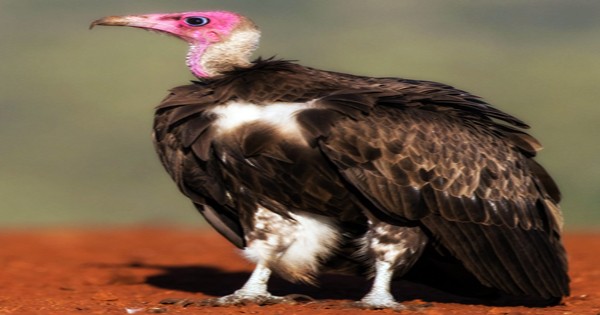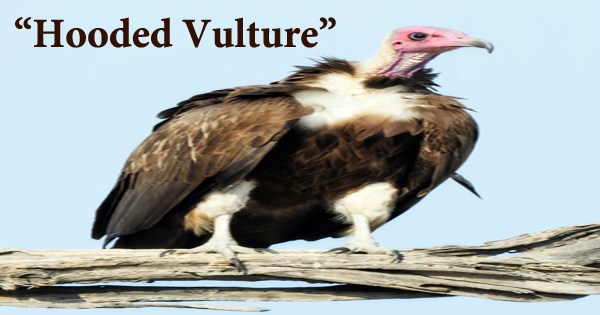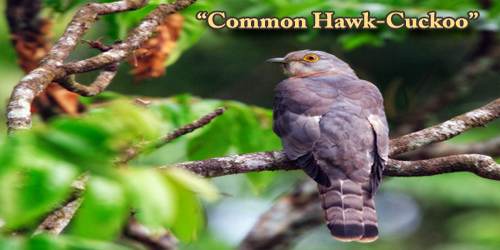The hooded vulture (Necrosyrtes monachus) is one of the smallest Old World vultures, closely related to eagles and hawks. It is the lone member of the genus Necrosyrtes, which is sister to the larger Gyps genus and both belong to the Aegypiinae Old World vulture subfamily. Females have a bigger body size than men. Their beaks are tiny and feeble, and their tails are short and rounded. The birds’ exposed skin is reddish-pink, although it can turn bluish when they’re excited. They have weak feet that are designed for walking and running rather than grasping limbs. It is native to Sub-Saharan Africa, where it can be found in southern, eastern, and western parts of the continent. It’s a scruffy-looking tiny vulture with dark brown plumage, a long thin bill, a bald crown, face, and fore-neck, as well as a downy nape and hind-neck. It has a pale reddish-brown face. It feeds on the carcasses of both wild and farmed animals. These vultures have dark brown feathers. They devour dead animals or carrion as scavengers, relying on their beaks and talons to consume their prey, which can be messy. Vultures have a difficult time cleaning their heads, but they can quickly shake off the mess. The remaining germs will be killed by the sun, which is why they are bald. Although it is still a common species with a stable population in the lower Casamance region, some sections of The Gambia, and Guinea-Bissau, other localities, such as Dakar, Senegal, have seen population reductions of more than 85% in the last 50 years. Poisoning, poaching, habitat degradation, and collisions with electricity infrastructure are all threats, and the International Union for Conservation of Nature has classified it as “critically endangered” in its most recent assessment (2017). The Gambia’s western region has the highest current regional density of hooded vultures. The hooded vulture can be found in a variety of habitats in Sub-Saharan Africa, including Kenya, Uganda, Tanzania, and other nations, including semi-deserts, coastal lowlands, forests, and open woodlands. It is most widespread in savannahs and grasslands, particularly near human settlements, because villages and cities provide ample food. They settle in cattle ranches in Tanzania’s and Kenya’s sparsely populated grasslands, picking up carrion and scraps from nearby farms. Despite their seemingly “unappetizing” feeding habits, all vultures are clean birds that bathe frequently. It’s a really useful bird to have around since it cleans up all kinds of trash that, if left unchecked, could lead to illness and disease.

Hooded Vultures are little vultures with a wingspan of about 26 inches. The term “hooded vulture” comes from a thin patch of downy feathers that runs up the back of the vulture’s neck to the crown of its head, giving it the appearance of a fluffy, cream-colored hood. Adults have downy white feathers on the back of the neck that form a hood on the head, as well as a white-collar. The face is generally greyish, but when enthusiastic, it can turn bright pink, red, or even bluish. When blood vessels dilate in a highly stimulation or aggressive state, the color of the naked skin of the neck and head may change. This is an entirely automatic reaction that serves as a warning to the other vultures. Its skin turns pale or greyish white when it is startled. The young of the Hooded Vulture are wholly brown; however, the adults have white patches that emphasize the dark colors in some areas. The bird’s bill is long and slender, making it easy to identify. Its wings are shorter, wider, and less pointed in flight than the Egyptian Vulture’s. They are 62–72 cm (24–28 in) long, have a wingspan of 155–180 cm (61–71 in), and bodyweight of 1.5–2.6 kg (3.3–5.7 lb). Although females have longer eyelashes than males, both sexes have similar appearances. Juveniles have a purple gloss to their body feathers and are darker and plainer than adults. It features a squared tail rather than a pointed one, and it is completely black. The pale flight feather bases make a scattered pattern on the underwing of adults. The Hooded Vulture is a common sight, and it often travels in groups. Throughout much of this bird’s range, a few can be seen soaring in the sky at virtually any time of day. Its strong toes are good for walking and sprinting, but not for grabbing prey. Hooded vultures are more daring than most other vultures, and they approach humans. Because it is smaller than many other vultures, it can take off more quickly and is often the first to find carrion. When being fed, chicks will chirp to their parents, although adults are normally silent. Hooded Vultures are opportunistic feeders and scavengers who eat food from a variety of sources. A major source is a decomposing flesh (carrion) from animal carcasses. It waits its time at a cadaver to pick up minor bits left behind by other vultures because of its small size and weak bill. They look for food in garbage dumps and gutters in towns and cities. They eat mussels, spiny lobsters, mollusks, dead fish, and other stranded foods on seashores during low tide. Grasshoppers, grubs, and locusts are also eaten by them. It lays one egg in a stick nest in trees (typically palms) throughout much of Africa south of the Sahara. Birds have been known to create loose colonies. The majority of the population is sedentary and rarely travels more than 200 kilometers. The Kruger National Park and neighboring protected regions in Mpumalanga and Limpopo provinces are practically the only places in South Africa where the species may be found, though vagrants have been reported further west in Kwa-Zulu Natal and the Kgalagadi Transfrontier Park. The mother is highly attentive and only lays one egg. Both parents, though mostly the female, who is fed by the male in the nest, incubate for 48 to 54 days. When the baby hatches, it is quite frail and requires a lot more attention from its parents than other vultures. The chick will be completely reliant on its parents for seven months, by which time it will have developed all of its plumage and flown for the first time. When the Hooded Vulture rises, it holds its wings like enormous vultures, and when it descends, it drops them, darkening its body. It takes flight faster than most other vultures since it is smaller, and it is generally the first to find a cadaver. Mated pairs of these vultures are loyal to each other, roosting together outside of the breeding season. They frequently roost near the breeding place they select. The population will be minimal in locations where there is little human activity; nonetheless, the savannahs of Central and West Africa have a large population.
















